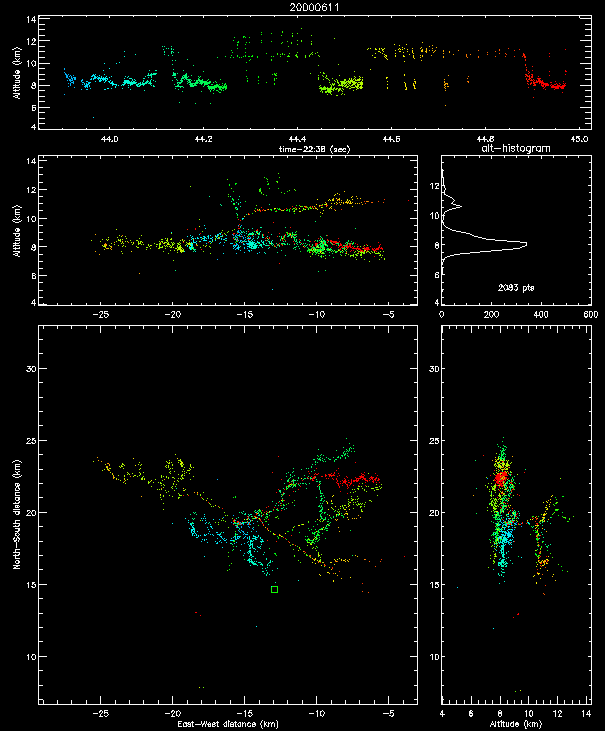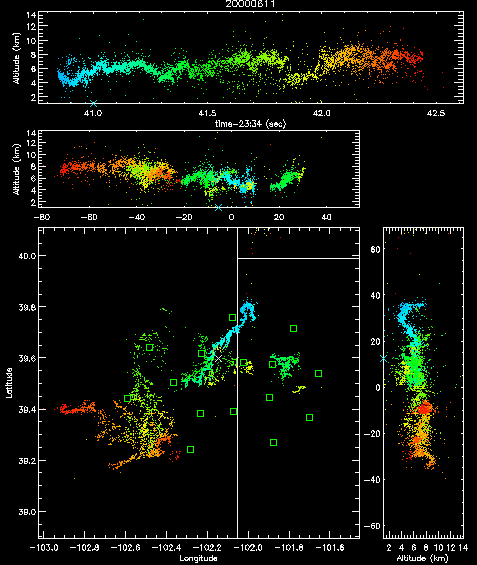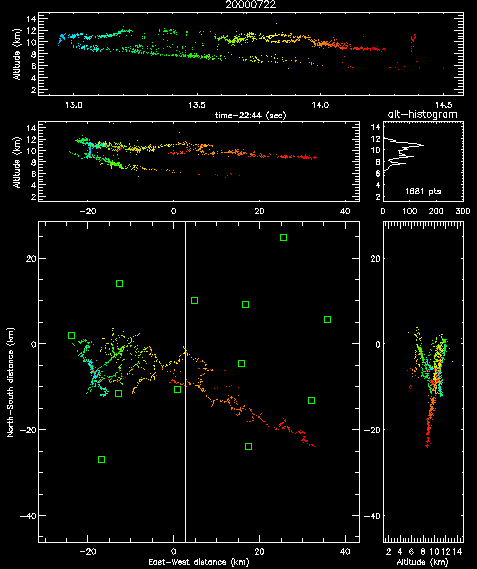In normally-electrified storms, the cloud-to-ground (CG) discharges lower negative charge to ground from mid-levels (7-8 km altitude MSL ) in the storm. However, in some storms the CG lightning is predominantly of positive polarity, namely the discharges lower positive charge to ground. One of the primary objective of STEPS was to study storms of this type. Climatologically, the highest incidence of the +CG storms is in the northwestern Kansas/eastern Colorado area. This is why STEPS was conducted in the area. Before the program began, it was thought that we would be lucky to observe one or two +CG storms. It turned out that, although it was a very dry season, +CG storms were commonplace. Half or more of the storms that occurred in and around the project area were of the +CG variety.
We were able to analyze quite a bit of lightning data while the project was going on. What we found was that in the +CG storms the intracloud (IC) lightning is also inverted in polarity. IC discharges normally occur between negative charge at mid-levels in the storm and positive charge in the upper part of the storm. In the predominantly +CG storms, the IC discharges did the opposite, They were in fact `upside down'. Instead of starting at mid-levels in the storm and developing upward, as in normal storms, the inverted IC discharges start in the upper part of the storm and develop downward. Similar discharges were also observed with the mapping system in Oklahoma during 1998. Measurements of the electric field changes produced by the lightning confirmed that the discharges were inverted; instead of negative charge being raised in the storm, it was lowered. There are innumerable examples of such discharges in the data. The findings indicate that the electrification of the parent storm is also inverted in polarity.
Shown below are a few examples showing the kind of observations obtained with the mapping system. Other parts of this web page show additional examples. There were many more features to the lightning than we present here, they will be added into later versions of the web page.
The first figure shows an inverted polarity intracloud discharge that occurred at 22:38:44 UTC in the asymmetric bow echo storm of June 11. The discharge occurred in the active northern part of the storm, which had been producing almost exclusively positive polarity CG discharges. The discharge started just below 10 km altitude and propagated down into and through horizontally extensive positive charge centered around 8 km altitude. The upper level channels, in the inferred negative charge region, were `thin' in comparison to the lower level channels. Interestingly, part of the upper level channels developed vertically upward in the storm.

The next figure shows a +CG discharge in the same part of the storm. The discharge occurred at 22:38:13, 30 seconds earlier than the inverted IC shown above. It started at about 5 km altitude and propagated upward into and through the positive charge region. The positive ground stroke occurred about 0.2 second after the beginning of the discharge. (The time and location of the stroke is denoted by the green cross in the vertical panels and by the partially obscured white cross in the plan view.) Time animations of the flash show a rapid `blossoming' of new breakdown inside the cloud immediately following the stroke, that developed rapidly away from the channel to ground. The renewal and rapid expansion of the breakdown is so obvious in this and other flashes that one can usually tell when a ground stroke occurred from the blossoming alone. As has been noted in other studies, the channel to ground is not imaged because the leader radiates very weakly at VHF. Late in the flash, breakdown occurred between the far ends in the positive charge region and a small horizontal region at 5 km altitude around the starting point of the flash (the red points in the figure). Negative charge may have been at this level, which may have caused the flash to be initiated in the first place.

The next figure shows a positive CG discharge that occurred about an hour later in the same storm, this time in an extensive trailing stratiform region that had developed behind the leading edge of the storm. The discharge started over the northern edge of the network and propagated 100 km (60 miles) to the southwest. It produced a single stroke to ground immediately east of Bonny State Park. The stroke was again accompanied by a rapid and marked blossoming of the breakdown away from the ground contact point up in the cloud. At the time of the ground stroke, the in-cloud channels were almost 20 km ahead of the stroke location. This is consistent with the idea that the older, original parts of the channel had cut off, causing the positive charge being funneled back from ahead to cause breakdown to ground. Horizontally extensive discharges similar to this were occurring every 4 or 5 minutes in the storm, typical of the activity in trailing stratiform regions.

Shown below is another inverted-polarity intracloud discharge, selected more or less at random from our files. This one occurred at 20:01:19 UTC on July 22, southwest of the mapping network. Both this and the next discharge were captured in the real time data. The mid-level positive charge region appeared to slope downward from about 9 km altitude at the northern end of the discharge to about 5 km altitude at the southern end.

Last but not least, we show a NORMAL polarity intracloud discharge. Inverted polarity IC discharges were so common and abundant that it was reassuring to discharges of the `normal' polarity, to make sure we weren't just dreaming. The discharge shown below caught our eye because of the long, dagger-like channel that developed well away from the main part of the flash, in the upper positive charge level.

![[Go Back to STEPS 2000]](images/goback.jpg) Go Back to STEPS 2000
Go Back to STEPS 2000